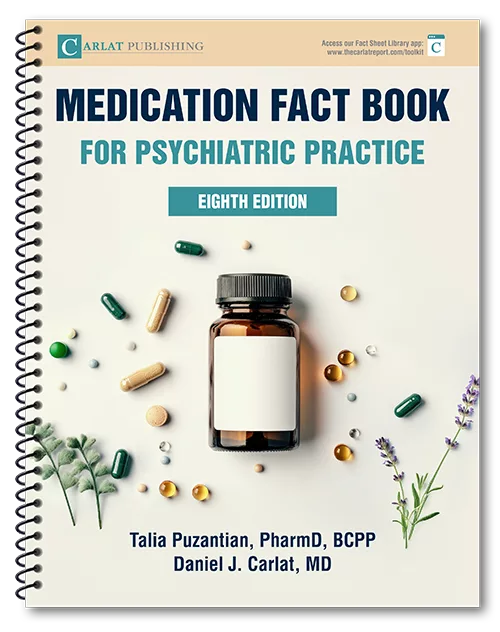Home » Eating Disorder Treatment Challenges
Eating Disorder Treatment Challenges
September 1, 2012
From The Carlat Psychiatry Report
Sarah O’Neil, MD
Child, adolescent, and adult psychiatrist
Dr. O’Neil has disclosed that she has no relevant financial or other interests in any commercial companies pertaining to this educational activity.
Even though she denies any problems, deep inside your patient feels out of control, her life a treadmill gone haywire. She feels numb to any emotional experience and feels absent from her own life. She fragments herself into two selves, her public persona, always competent and in control, and the hidden, secret self of the eating disorder, until her mind no longer has the energy to preserve that duality.
An eating disorder is a terrible thing to live with.
Let’s be blunt. Without recognition and appropriate management of the “secret self” of the eating disorder, patients can die. Anorexia has the highest mortality rate of any psychiatric illness, and mortality correlates with the extent and duration of starvation. Sufferers are 5.6 times more likely to die than their peers in an age-matched population. The cause of death is divided evenly among suicide, cardiac disease (heart failure and arrhythmias), and starvation-related causes. With bulimia, medical complications are related to frequency and mode of purging. Both illnesses can cause potentially lethal complications in nearly every organ system (Mahler PS, Int J Eat Disorder 2011;44(2):95–104).
But diagnosis can be difficult, especially if you simply focus on diagnostic criteria. Instead, I advise framing questions in three general categories: disturbed eating habits; extreme methods of weight control; and concerns about weight and shape (inability to see weight loss and inability to appreciate medical seriousness of the illness) (Cooper Z and Fairburn CG, Intl J Eating Dis 1987;6:1–8).
The following accounts illustrate these domains:
Disturbed Eating Habits
Restriction and bingeing are the most obvious food-related behaviors to look for, but rituals and obsessiveness about food can also be a clue to an eating disorder. Extremely rigid meal schedules and patterns, or an excessive degree of knowledge about foods and their content are common.
Mary decided to cut out desserts, then fat in general, then meat, and then carbohydrates. It was as if, with each food eliminated, she was having a revelation: “If a serving of M&Ms has this much fat, then one M&M has this much.” Then, Mary “realized” she was supposed to stop eating as soon as her belly stopped growling. She had no concept that her eating habits were no longer normal.
Extreme Weight Control Methods
While dieting and concerns over weight and shape are commonplace in our society, patients with eating disorders take these concerns to a new level. Self-induced purging is a hallmark of bulimia, but you should also explore other forms of non-purging compensatory behaviors, which can be extreme and at times irrational.
Soon after starting her diet, Emily decided she needed to exercise to burn every calorie she had eaten. She had no concept that her eating habits were no longer normal. Exercise felt cathartic, even if it meant several hundred sit-ups each day or waking up at 4 am to get an elliptical machine at her gym.
Concerns about Weight and Shape
As important as evaluating the behavior in an eating disorder is understanding the motivation behind the behavior. All eating disorders share one central, overvalued idea: weight is somehow the only factor in assessment of worth by self and others. It is critical to understand this organizing truth if one is going to work with an eating-disordered patient (see TCPR, October 2007). This belief, to the patient, is self-evident. “How else would someone assess me?” she asks. She cannot—or will not—acknowledge the cognitive distortion, because she sees no distortion. As a result, she also cannot recognize the danger she’s in due to her weight loss or purging. Instead, she believes seamlessly and without question that others will be impressed by her thinness and like her more because of her control over eating. She also ashamedly believes that if others knew of her secret bingeing and self-induced vomiting, they would despise her.
At no point during her eating disorder did Heather ever perceive any weight loss. She lost more than 20 pounds but continued to see her old body, which she regarded with disgust and loathing. She felt she had to keep going; she would know that this “project” was done when she had achieved a proper size. Heather envisioned an emotional resolution, an “aha” experience that would let her know that she had reached her goal, and her problems would be solved. That time never came.
Denial and Lack of Insight
It is also common for patients with eating disorders to be in denial that they have a problem and to have a lack of insight into their own behavior.
As Scott entered the sixth month of his rigorous training regimen, he began to lose his tolerance for exercise. He fell off his bike after losing his balance, and after riding several miles in the heat, he heard a loud ringing in his ears. He swore it was the power lines above, but his companion couldn’t hear a thing. For several minutes, Scott insisted there was a noise until he finally realized that it was his own ears ringing.
Anna didn’t understand why everyone was so anxious. Sure, her resting pulse was 45, but she felt fine and she read somewhere that that was normal for people in good physical condition. She ignored the fact that it hurt to sit, her face was fuzzy, her hair was drab and thinner, her skin was dry, and she was dizzy and sweaty when she stood up too quickly. After all, she was still getting excellent grades, so what was the big deal?
General PsychiatryAn eating disorder is a terrible thing to live with.
Let’s be blunt. Without recognition and appropriate management of the “secret self” of the eating disorder, patients can die. Anorexia has the highest mortality rate of any psychiatric illness, and mortality correlates with the extent and duration of starvation. Sufferers are 5.6 times more likely to die than their peers in an age-matched population. The cause of death is divided evenly among suicide, cardiac disease (heart failure and arrhythmias), and starvation-related causes. With bulimia, medical complications are related to frequency and mode of purging. Both illnesses can cause potentially lethal complications in nearly every organ system (Mahler PS, Int J Eat Disorder 2011;44(2):95–104).
But diagnosis can be difficult, especially if you simply focus on diagnostic criteria. Instead, I advise framing questions in three general categories: disturbed eating habits; extreme methods of weight control; and concerns about weight and shape (inability to see weight loss and inability to appreciate medical seriousness of the illness) (Cooper Z and Fairburn CG, Intl J Eating Dis 1987;6:1–8).
The following accounts illustrate these domains:
Disturbed Eating Habits
Restriction and bingeing are the most obvious food-related behaviors to look for, but rituals and obsessiveness about food can also be a clue to an eating disorder. Extremely rigid meal schedules and patterns, or an excessive degree of knowledge about foods and their content are common.
Mary decided to cut out desserts, then fat in general, then meat, and then carbohydrates. It was as if, with each food eliminated, she was having a revelation: “If a serving of M&Ms has this much fat, then one M&M has this much.” Then, Mary “realized” she was supposed to stop eating as soon as her belly stopped growling. She had no concept that her eating habits were no longer normal.
Extreme Weight Control Methods
While dieting and concerns over weight and shape are commonplace in our society, patients with eating disorders take these concerns to a new level. Self-induced purging is a hallmark of bulimia, but you should also explore other forms of non-purging compensatory behaviors, which can be extreme and at times irrational.
Soon after starting her diet, Emily decided she needed to exercise to burn every calorie she had eaten. She had no concept that her eating habits were no longer normal. Exercise felt cathartic, even if it meant several hundred sit-ups each day or waking up at 4 am to get an elliptical machine at her gym.
Concerns about Weight and Shape
As important as evaluating the behavior in an eating disorder is understanding the motivation behind the behavior. All eating disorders share one central, overvalued idea: weight is somehow the only factor in assessment of worth by self and others. It is critical to understand this organizing truth if one is going to work with an eating-disordered patient (see TCPR, October 2007). This belief, to the patient, is self-evident. “How else would someone assess me?” she asks. She cannot—or will not—acknowledge the cognitive distortion, because she sees no distortion. As a result, she also cannot recognize the danger she’s in due to her weight loss or purging. Instead, she believes seamlessly and without question that others will be impressed by her thinness and like her more because of her control over eating. She also ashamedly believes that if others knew of her secret bingeing and self-induced vomiting, they would despise her.
At no point during her eating disorder did Heather ever perceive any weight loss. She lost more than 20 pounds but continued to see her old body, which she regarded with disgust and loathing. She felt she had to keep going; she would know that this “project” was done when she had achieved a proper size. Heather envisioned an emotional resolution, an “aha” experience that would let her know that she had reached her goal, and her problems would be solved. That time never came.
Denial and Lack of Insight
It is also common for patients with eating disorders to be in denial that they have a problem and to have a lack of insight into their own behavior.
As Scott entered the sixth month of his rigorous training regimen, he began to lose his tolerance for exercise. He fell off his bike after losing his balance, and after riding several miles in the heat, he heard a loud ringing in his ears. He swore it was the power lines above, but his companion couldn’t hear a thing. For several minutes, Scott insisted there was a noise until he finally realized that it was his own ears ringing.
Anna didn’t understand why everyone was so anxious. Sure, her resting pulse was 45, but she felt fine and she read somewhere that that was normal for people in good physical condition. She ignored the fact that it hurt to sit, her face was fuzzy, her hair was drab and thinner, her skin was dry, and she was dizzy and sweaty when she stood up too quickly. After all, she was still getting excellent grades, so what was the big deal?
TCPR Verdict:
Eating disorders are challenging to treat and to diagnose. The quest for thinness and the misguided self-assessment based on weight is ego-syntonic; patients do not see themselves as ill. However, at some level, even the most refractory patients are trapped and scared. By learning to recognize and understand the patterns these illnesses often present, you can begin the process of freeing these patients to live full and flexible lives.
Eating disorders are challenging to treat and to diagnose. The quest for thinness and the misguided self-assessment based on weight is ego-syntonic; patients do not see themselves as ill. However, at some level, even the most refractory patients are trapped and scared. By learning to recognize and understand the patterns these illnesses often present, you can begin the process of freeing these patients to live full and flexible lives.
KEYWORDS eating_disorders
Issue Date: September 1, 2012
Table Of Contents
Recommended
Newsletters
Please see our Terms and Conditions, Privacy Policy, Subscription Agreement, Use of Cookies, and Hardware/Software Requirements to view our website.
© 2025 Carlat Publishing, LLC and Affiliates, All Rights Reserved.


_-The-Breakthrough-Antipsychotic-That-Could-Change-Everything.webp?t=1729528747)



